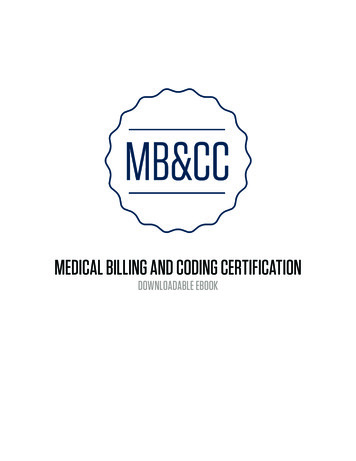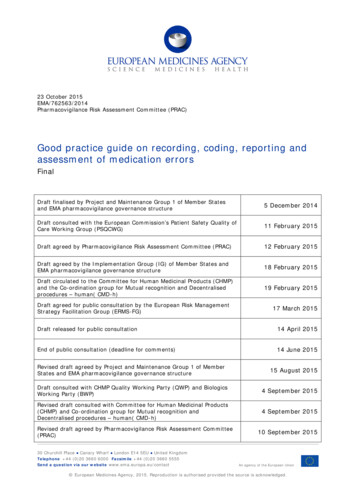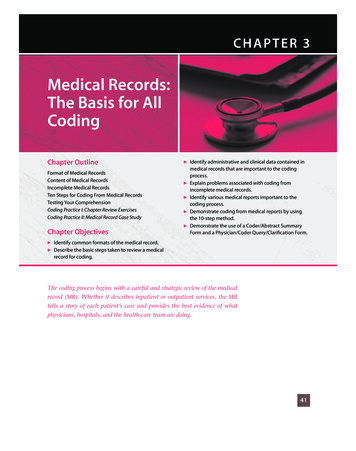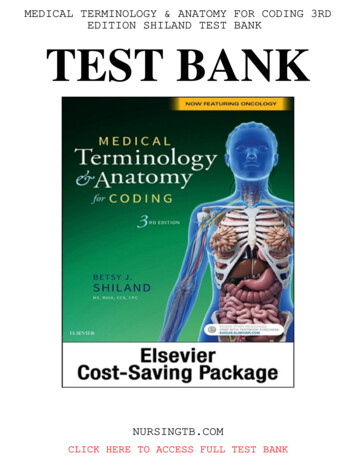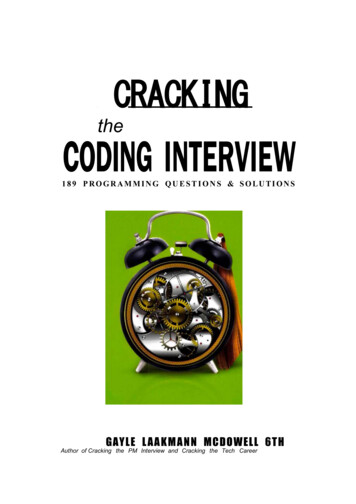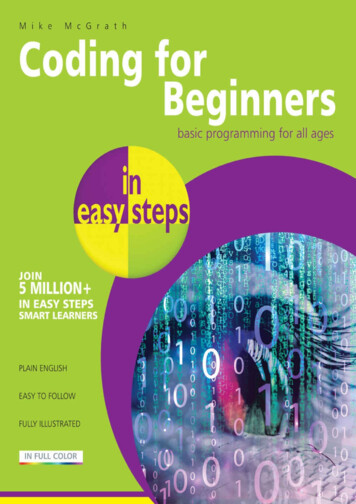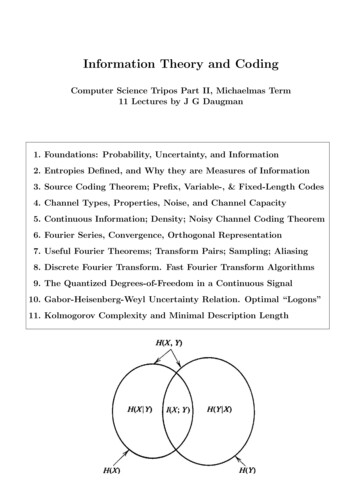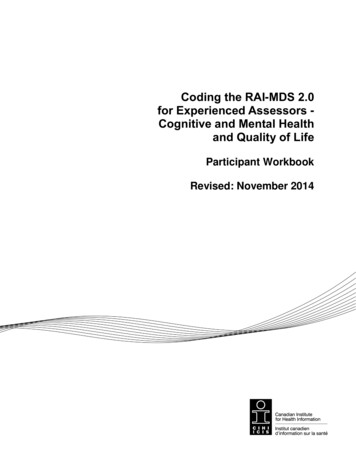
Transcription
Coding the RAI-MDS 2.0for Experienced Assessors Cognitive and Mental Healthand Quality of LifeParticipant WorkbookRevised: November 2014
All rights reserved.The contents of this publication may be reproduced unaltered, in whole orin part and by any means, solely for non-commercial purposes, provided thatthe Canadian Institute for Health Information is properly and fully acknowledgedas the copyright owner. Any reproduction or use of this publication or its contentsfor any commercial purpose requires the prior written authorization of the CanadianInstitute for Health Information. Reproduction or use that suggests endorsement by,or affiliation with, the Canadian Institute for Health Information is prohibited.For permission or information, please contact CIHI:Canadian Institute for Health Information495 Richmond Road, Suite 600Ottawa, Ontario K2A 4H6Phone: 613-241-7860Fax: 613-241-8120www.cihi.cacopyright@cihi.ca 2014 Canadian Institute for Health Information Based upon the Resident Assessment Instrument (RAI) RAI-MDS 2.0 User’s Manual, CanadianVersion, 2012. The RAI-MDS 2.0 is interRAI Corporation, Washington, D.C., 1997, 1999. Modified withpermission for Canadian use under licence to the Canadian Institute for Health Information. Canadianizeditems and their descriptions are protected by copyright: 2002, Canadian Institute for Health Information.CIHI 2014-20152
Coding the RAI-MDS 2.0 for Experienced Assessors:Cognitive and Mental Health and Quality of LifeTable of ContentsAbout CIHI . 4Acknowledgements . 4Objectives . 5Materials Needed . 5Coding and Interpreting. 6RAI-MDS 2.0 Guidelines . 6RAI CODE Critical-Thinking Strategy. 7Pre-Work Activity . 8Activity 1 – Interpret Coding. 9Activity 2 – Coding and Interpreting .17Data Quality .31Ensuring Quality Data for Quality Care .31Activity 3 - Data Quality .33CIHI 2014-2015i
About CIHIThe Canadian Institute for Health Information (CIHI) collects and analyzes information on healthand health care in Canada and makes it publicly available. Canada’s federal, provincial andterritorial governments created CIHI as a not-for-profit, independent organization dedicatedto forging a common approach to Canadian health information. CIHI’s goal: to provide timely,accurate and comparable information. CIHI’s data and reports inform health policies, supportthe effective delivery of health services and raise awareness among Canadians of the factorsthat contribute to good health.AcknowledgementsCIHI wishes to acknowledge and thank interRAI and staff at participating organizations acrossCanada who provided expertise and support and who volunteered to pilot the Coding theRAI-MDS 2.0 for Experienced Assessors: Cognitive and Mental Health and Quality of Lifetraining. Their generous contribution has allowed us to provide you with this education material.We would like to thank the residents/clients, staff and volunteers at the Élisabeth BruyèreResidence, Extendicare Starwood, Bethany Care Society and Champlain Community CareAccess Centre for giving CIHI permission to use their pictures, including those of their familiesand homes.All names and stories used in this training are fictitious.SymbolsImportant NoteCIHI 2014-20154
Coding RAI-MDS 2.0 Experienced Assessors – Cognitive and Mental Healthand Quality of LifeObjectivesThe web conference Coding the RAI-MDS 2.0 for Experienced Assessors: Cognitive andMental Health and Quality of Life is a two and a half hour activity-based training session. Thissession covers the following sections of the RAI-MDS 2.0 assessment: Section B: Cognitive Patterns Section E: Mood and Behaviour Patterns Section F: Psychosocial Well-Being Section N: Activity Pursuit PatternsIn this training, you will Use the RAI-MDS 2.0 User’s Manual to interpret and apply coding standards in the areasof Cognitive and Mental Health and Quality of Life; Document Cognitive and Mental Health and Quality of Life assessment findings using theRAI CODE critical-thinking strategy; and Identify ways to improve data quality in your facility.The primary intent is for you to engage in peer discussion and sharing. In this session, you willdraw on each other’s clinical judgment and expertise to code vignettes where the interpretationof the coding standards for documenting items becomes challenging. You will also explore theconsequences of incorrect coding for clinical and organizational decision-supporting yourfacility.Materials NeededThe following materials are required for this web conference: Resident Assessment Instrument (RAI) RAI-MDS 2.0 User’s Manual Coding the RAI-MDS 2.0 for Experienced Assessors: Cognitive and Mental Health andQuality of Life Participant WorkbookCIHICIHI2014-20155
Coding RAI-MDS 2.0 Experienced Assessors – Cognitive and Mental Healthand Quality of LifeCoding and InterpretingRAI-MDS 2.0 GuidelinesAs described in the RAI-MDS 2.0 Manual, there are several integral concepts used to assistclinicians in documenting assessment findings. These include: The resident is a person with strengths, preferences and needs Clinical Assessment Protocols identify persons with potential to improve and those at risk ofdecline An interdisciplinary approach to resident care is vital – both in assessment and indeveloping the resident’s care plan Good clinical practice requires sound assessment skillsUsing the RAI-MDS 2.0 Guidelines in the assessment process Minimum data set (MDS) Observation period is the seven days prior to the assessment reference date, unless alonger time frame is specified Information is obtained from multiple sources Clinical judgment is key—it is not a questionnaire Coding standards guide the assessment process Coding reflects resident’s functioning Regardless of the assumed cause With assistive/adaptive aids in placeAll sections work together to give a holistic view of the residentCIHICIHI2014-20156
Coding RAI-MDS 2.0 Experienced Assessors – Cognitive and Mental Healthand Quality of LifeRAI CODE Critical-Thinking StrategyThis mnemonic helps guide the critical-thinking process that often occurs intuitively as part ofyour assessment process. It is a tool for reflective problem-solving and decision-making.CIHICIHI2014-20157
Coding RAI-MDS 2.0 Experienced Assessors – Cognitive and Mental Healthand Quality of LifePre-Work ActivityIn This Activity You WillPrior to the web conference: Read the vignettes for Activity One and Activity Two Activity #1 – Vignettes 1 and 2 Activity #2 – Vignettes 1 and 2Note: The documentation of your findings and rationale will be completed during the webconference. Approximate time to complete: 10 minutesCIHICIHI2014-20158
Coding RAI-MDS 2.0 Experienced Assessors – Cognitive and Mental Healthand Quality of LifeActivity 1 – Interpret CodingIn This Activity You Will Review each vignette and associated coding You will use the following resources:- Participant workbook: Activity One—vignettes 1 and 2- RAI-MDS 2.0 guidelines found on page 6- RAI CODE critical-thinking strategy found on page 7- Example – Average Time Involved in Activities (N2) on page 13- RAI-MDS 2.0 User’s Manual As a group, document your rationale for the coding of each vignette Present your findings and participate in discussions Time allotted: 15 minutesCIHICIHI2014-20159
Coding RAI-MDS 2.0 Experienced Assessors – Cognitive and Mental Healthand Quality of LifeVignette 1: Mr. T—F1, F2 and F3Mr. T has been a widower for 20 years. He worked as a landscape architect before he retired.He was admitted to Rainbow LTC home two years ago following a CVA resulting inright-sided paralysis. Mr. T shares a semi-private room with Mr. B, a younger resident with abrain injury.Mr. T spends most of his time in his room working on his laptop. He has stated to staff that hewould like to finish writing his book before he dies. He has asked to be moved to a private roomwhen one becomes available. Communication between him and his roommate is challenging;he says he has no quiet time as his roommate has frequent visitors and is noisy at night. Mr. T’sson has tried to communicate with him using Skype, but Mr. T refused, saying he is upset thathis son sold the family home and moved to South America with his family rather than caring forhim at home.He is an experienced gardener and had enjoyed volunteering at the local chapter of theHorticultural Society prior to admission. He has not done any gardening this summer. He saysit’s not the same without Frank, who was a volunteer at the facility. Mr. T had developed afriendship with Frank, and when Frank moved to Edmonton with his daughter four months ago,Mr. T stopped going to the garden. He says he misses Frank very, very much. This was the onlygroup activity he attended and enjoyed.CIHICIHI2014-201510
Coding RAI-MDS 2.0 Experienced Assessors – Cognitive and Mental Healthand Quality of LifeReview the responses and document your rationale for coding of the items in F1, F2 and F3 forMr. T.Rationale:Rationale:CIHICIHI2014-201511
Coding RAI-MDS 2.0 Experienced Assessors – Cognitive and Mental Healthand Quality of LifeRationale:Important NoteIn the Index of Social Engagement (ISE), all items from Section F1 (Sense ofinitiative/involvement) are used in the calculation of this outcome scale.CIHICIHI2014-201512
Coding RAI-MDS 2.0 Experienced Assessors – Cognitive and Mental Healthand Quality of LifeExample—N2Average Time Involved in Activity Pursuits (N2)The past 7 days, Mrs. B woke up around 7 a.m. She listened to the news on TV until the PSWcame in to assist her with morning care. Once in her wheelchair, she pushed herself to thedining room for breakfast. At 9 a.m. she went to the activity room and participated in groupexercise led by the recreation therapy assistant. At 10 a.m. the nurse gave Mrs. B hermedications, followed by a dressing change to her right foot. By 11 a.m., Mrs. B sat inher recliner chair and knitted.After lunch, she took a one-hour nap. She had the volunteer wake her up for the 2 p.m. activity(cooking and music sessions). Mrs. B spent her afternoons in the lounge chatting with otherresidents or sitting outside on the patio feeding birds.After supper, Mrs. B napped as usual and got up when her husband arrived. Just before he leftat 10 p.m., he helped her with undressing and getting her in bed. On his way out, he notified thenurse so Mrs. B’s HS medications could be administered.Code 0 (Most—more than 2/3 of the time)Rationale: Mrs. B was actually involved in activity pursuits more than two-thirds of the availablefree time she had in the last seven days. She was asleep approximately 11 out of 24 hours. She received nursing care/treatments or was engaged in ADL activities approximately 6out of 24 hours. This left her approximately 7 out of 24 hours to pursue various activities.She used most of these 7 hours participating in group activities (exercise, music and cookingsessions) and being involved in one-on-one activities (watching TV, knitting, reading and feedingbirds). She was also involved in chatting with other residents in the afternoons and visiting with herhusband in the eveningCIHICIHI2014-201513
Coding RAI-MDS 2.0 Experienced Assessors – Cognitive and Mental Healthand Quality of LifeVignette 2: Mr. D—N1, N2, N3, N4 and N5Mr. D is a 58-year-old man who has Down’s Syndrome with dementia. He was recentlyadmitted to Harmony Nursing Home after his mother, who was his primary caregiver, suddenlypassed away.He wakes up at 7:00 a.m. every morning and tends to be lethargic. He takes a half hour napevery morning and afternoon because he sleeps poorly at night. He is most active in the middleof the afternoon. Mr. D enjoys walking outside on the grounds every day with a volunteer andenjoys their conversations. Most afternoons, Mr. D meets the horticultural therapist andtogether they water the plants, weed the garden and feed the birds. He also enjoys sitting in thegazebo and listening to his music. Mr. D has a congenital heart defect and requires frequentrest periods; he is found watching TV or looking at magazines in his room later in the afternoonsand early in the evenings. He is usually in bed by 11 p.m. Having vision and hearing deficitsmakes it more difficult for him to participate in group activities. So far, he has not participated ingroup activities with other residents; he is very shy and prefers one-on-one interaction withothers or time alone.On admission, his brother George shared with the staff that Mr. D has always been a loner andhas never socialized much. George reinforced with the staff the importance of a structuredenvironment for Mr. D. He has always had difficulty transitioning to new activities and schedulechanges. His brother added that Mr. D might like to go to the church service on Friday morningif someone accompanied him.CIHICIHI2014-201514
Coding RAI-MDS 2.0 Experienced Assessors – Cognitive and Mental Healthand Quality of LifeReview the responses and document your rationale, on the next page, for coding of the items inN1, N2, N3, N4 and N5 for Mr. DCIHICIHI2014-201515
Coding RAI-MDS 2.0 Experienced Assessors – Cognitive and Mental Healthand Quality of LifeRationale:CIHICIHI2014-201516
Coding RAI-MDS 2.0 Experienced Assessors – Cognitive and Mental Healthand Quality of LifeActivity 2 – Coding and InterpretingIn This Activity You Will Review each vignette You will use the following resources:–Participant workbook: Activity Two—vignettes 1 and 2 including tracking forms–RAI-MDS 2.0 guidelines found on page 6–RAI CODE critical-thinking strategy found on page 7–RAI-MDS 2.0 User’s Manual As a group, document your findings for each vignette and identify any other areas on theassessment where you would capture this information. What items impact the outcomescale scores in Section B (Cognitive Patterns) and Section E (Mood and BehaviourPatterns)? Present your findings and participate in discussions Time allotted: 20 to 25 minutesCIHICIHI2014-201517
Coding RAI-MDS 2.0 Experienced Assessors – Cognitive and Mental Healthand Quality of LifeVignette 1: Miss J—Sections B2, B3, B4, B5 and B6ARD: Thursday, September 25, 2014Miss J has been at the New Star LTC home for three months now. She was admitted forrehabilitation following a stroke, and she is hoping to return to her group home soon. Miss J hasschizophrenia which is being closely monitored and has been reported as stable since heradmission. She has adapted well to her temporary placement.In the past week, staff reported that she was having trouble remembering what she ate for lunchwhen questioned five minutes after she finished her meal as she was walking back to her roomindependently. However, she was able to recall her birthday. Normally, she is able to recallwhat season it is and able to recognize staff members by name. When asked where she lives,she indicated that she is in a home for old people until she gets better and can go back to hergroup home where her friends live.Since admission, Miss J was usually able to choose her clothes for the day and know when towalk to the dining room for meals. However, since Tuesday (September 23), staff havereported that Miss J has been unable to find her assigned table in the dining room. She didn’tseem to realize that she kept sitting at different tables and she did not ask staff or volunteers forassistance. Yesterday (September 24), she arrived for breakfast in her pajamas and her winterjacket and she had her roommate’s shoes on. The health care aide offered to help her changeher clothes and she accepted willingly.In the evenings during HS care, staff noted that Miss J was having difficulty removing herclothes and, when handed the toothpaste, she didn’t know what to do with it. Before shefinished brushing her teeth, she started to brush her hair. She went on about a movie she sawlast month as if it had happened yesterday, then in the middle of a sentence she started to huma song. The day staff did not report this behaviour.The staff have also observed that Miss J is continuously picking at her clothes, trying toremove lint when none is apparent. However, that is not new for her; she’s been doing this formonths now.This morning (September 25) Miss J would not get up forbreakfast. She was difficult to rouse and speech was incoherent.Lori immediately reported her findings to the nurse practitioner,who ordered blood work.CIHICIHI2014-201518
Coding RAI-MDS 2.0 Experienced Assessors – Cognitive and Mental Healthand Quality of LifeCIHICIHI2014-201519
Coding RAI-MDS 2.0 Experienced Assessors – Cognitive and Mental Healthand Quality of LifeDocument your findings and rationale using the completed tracking form (where applicable) forSections B2, B3, B4, B5 and B6 for Miss J.CIHICIHI2014-201520
Coding RAI-MDS 2.0 Experienced Assessors – Cognitive and Mental Healthand Quality of LifeCIHICIHI2014-201521
Coding RAI-MDS 2.0 Experienced Assessors – Cognitive and Mental Healthand Quality of Life1. In reviewing Miss J’s story, identify other areas on the assessment where you would capturethis information (if applicable)?2. What items in Section B (Cognitive Patterns) impact the outcome scale scores?CIHICIHI2014-201522
Coding RAI-MDS 2.0 Experienced Assessors – Cognitive and Mental Healthand Quality of LifeVignette 2: Mr S. — Sections E1, E2, E3, E4 and E5ARD: Thursday, October 30, 2014Mr. S has been at the Cross Roads Manor for more than four years. He is pleasant and veryjovial, enjoys social activities and is always the first one to initiate gatherings. He plays hisharmonica for people when there are get-togethers in the lounge.Four months ago, he fell getting out of his son’s car and suffered a hip fracture. Followingsurgery, he returned to the home and was started on an intensive physiotherapy program. In thefirst six weeks, he was compliant with the program and was determined to get back on his feet.In the last month, when he realized his improvement was much slower than he expected, thestaff have observed changes in Mr. S’s mood. He has been looking sad and discouraged. Hestarted to find all kinds of reasons for not going to the gym or doing his exercises with the rehabassistant. He has been declining pain medication and staying in bed most of the day, saying hereally needs to rest. He has not wanted to be with others, and when going for meals he hasbeen keeping to himself and quickly returning to his room right after eating.Two weeks ago, when staff noticed a small pressure ulcer on his left buttock (stage 2), he toldthem he had no more energy to fight anythin
Coding RAI-MDS 2.0 Experienced Assessors – Cognitive and Mental Health and Quality of Life CIHICIHI 201 5 4-2015 Objectives The web conference Coding the RAI-MDS 2.0 for Experienced Assessors: Cognitive and Mental Health and Quality of Life is a two and a half hour activity-based training session. This




